The Relationship between NDVI and Climate Factors at Different Monthly Time Scales: A Case Study of Grasslands in Inner Mongolia, China (1982–2015)
Abstract
:1. Introduction
2. Materials and Methods
2.1. Study Area
2.2. Data Sources
2.3. Methods
2.3.1. Calculation of the NDVI Data at the Meteorological Stations
2.3.2. Correlation Analysis between NDVI and Climate Factors
2.3.3. Lag Analysis between NDVI and Climate Factors
3. Results
3.1. Temporal Changes in NDVI and Climate Factors
3.2. Correlation between NDVI and Climate Factors
3.2.1. Correlation between NDVI and Climate Factors in the Within-Growing Season
3.2.2. Correlation between NDVI and Climate Factors in the Inter-Growing Season
3.2.3. Change in the NDVI–Climate Relationship at Multiple Time Scales
4. Discussion
5. Conclusions
- (1)
- NDVI was affected by temperature and precipitation from 1982 to 2015 in the area, showing obvious periodic changes, and NDVI showed a certain time lag for climate factors.
- (2)
- The NDVI–climate relationship was quite different when comparing the within-growing season and the inter-growing season. NDVI had a high value of R with climate factors in the within-growing season, while the significant correlation between them was different in different months in the inter-growing season.
- (3)
- With the increase in time series, the value of R between NDVI and climate factors of all grassland types showed a trend of increase in the within-growing season, while the value of R between NDVI and precipitation decreased but then tended toward stability in the inter-growing season.
- (4)
- Due to the synchronization of rainfall and temperature, the correlation coefficients obtained by the within-growing season method were a kind of pseudo correlation, which may not truly reflect the impact of water and heat conditions on vegetation, so this method should be carefully used in the future. In the inter-growing season, the NDVI–climate relationship in different months was analysed separately, which can reduce the impact of rain and heat in the same period and may be more realistic to reflect the relationship between them. So the inter-growing season method is more suitable for the analysis of the NDVI–climate relationship.
Author Contributions
Funding
Acknowledgments
Conflicts of Interest
References
- Nemani, R.R.; Keeling, C.D.; Hashimoto, H.; Jolly, W.M.; Piper, S.C.; Tucker, C.J.; Myneni, R.B.; Running, S.W. Climate-driven increases in global terrestrial net primary production from 1982 to 1999. Science 2003, 300, 1560–1563. [Google Scholar] [CrossRef] [Green Version]
- Woodward, F.I.; Lomas, M.R.; Kelly, C.K. Global climate and the distribution of plant biomes. Philos. Trans. R. Soc. B 2004, 359, 1465–1476. [Google Scholar] [CrossRef] [PubMed] [Green Version]
- Xia, J.Y.; Chen, J.Q.; Piao, S.L.; Ciais, P.; Luo, Y.Q.; Wan, S.Q. Terrestrial carbon cycle affected by non-uniform climate warming. Nat. Geosci. 2014, 7, 173–180. [Google Scholar] [CrossRef]
- Liu, Y.; Li, L.; Chen, X.; Zhang, R.; Yang, J. Temporal-spatial variations and influencing factors of vegetation cover in Xinjiang from 1982 to 2013 based on GIMMS-NDVI3g. Glob. Planet. Chang. 2018, 169, 145–155. [Google Scholar] [CrossRef]
- Buitenwerf, R.; Rose, L.; Higgins, S.I. Three decades of multi-dimensional change in global leaf phenology. Nat. Clim. Chang. 2015, 5, 364–368. [Google Scholar] [CrossRef]
- Xu, Y.; Yang, J.; Chen, Y. NDVI-based vegetation responses to climate change in an arid area of China. Theor. Appl. Climatol. 2015, 126, 213–222. [Google Scholar] [CrossRef]
- Xu, X.; Du, H.; Fan, W.; Hu, J.; Mao, F.; Dong, H. Long-term trend in vegetation gross primary production, phenology and their relationships inferred from the FLUXNET data. J. Environ. Manag. 2019, 246, 605–616. [Google Scholar] [CrossRef]
- Wu, X.C.; Liu, H.Y.; Li, X.Y.; Ciais, P.; Babst, F.; Guo, W.C.; Zhang, C.C.; Magliulo, V.; Pavelka, M.; Liu, S.M.; et al. Differentiating drought legacy effects on vegetation growth over the temperate Northern Hemisphere. Glob. Chang. Biol. 2018, 24, 504–516. [Google Scholar] [CrossRef]
- Manea, A.; Sloane, D.R.; Leishman, M.R. Reductions in native grass biomass associated with drought facilitates the invasion of an exotic grass into a model grassland system. Oecologia 2016, 181, 175–183. [Google Scholar] [CrossRef]
- Na, L.; Na, R.; Zhang, J.; Tong, S.; Shan, Y.; Ying, H.; Li, X.; Bao, Y. Vegetation Dynamics and Diverse Responses to Extreme Climate Events in Different Vegetation Types of Inner Mongolia. Atmosphere 2018, 9, 394. [Google Scholar] [CrossRef] [Green Version]
- Fang, S.B.; Qi, Y.; Han, G.J.; Li, Q.X.; Zhou, G.S. Changing Trends and Abrupt Features of Extreme Temperature in Mainland China from 1960 to 2010. Atmosphere 2016, 7, 22. [Google Scholar] [CrossRef] [Green Version]
- Fang, S.B.; Qi, Y.; Yu, W.G.; Liang, H.Y.; Han, G.J.; Li, Q.X.; Shen, S.H.; Zhou, G.S.; Shi, G.X. Change in temperature extremes and its correlation with mean temperature in mainland China from 1960 to 2015. Int. J. Climatol. 2017, 37, 3910–3918. [Google Scholar] [CrossRef]
- Li, W.; Du, J.; Li, S.; Zhou, X.; Duan, Z.; Li, R.; Wu, S.; Wang, S.; Li, M. The variation of vegetation productivity and its relationship to temperature and precipitation based on the GLASS-LAI of different African ecosystems from 1982 to 2013. Int. J. Biometeorol. 2019, 63, 847–860. [Google Scholar] [CrossRef] [PubMed]
- Jiang, C.; Zhang, L.B. Climate Change and Its Impact on the Eco-Environment of the Three-Rivers Headwater Region on the Tibetan Plateau, China. Int. J. Environ. Res. Public Health 2015, 12, 12057–12081. [Google Scholar] [CrossRef] [Green Version]
- Shen, X.J.; Liu, B.H.; Zhou, D.W. Using GIMMS NDVI time series to estimate the impacts of grassland vegetation cover on surface air temperatures in the temperate grassland region of China. Remote Sens. Lett. 2016, 7, 229–238. [Google Scholar] [CrossRef]
- Lu, Q.; Zhao, D.; Wu, S.; Dai, E.; Gao, J. Using the NDVI to analyze trends and stability of grassland vegetation cover in Inner Mongolia. Theor. Appl. Climatol. 2018, 135, 1629–1640. [Google Scholar] [CrossRef]
- Guo, L.; Wu, S.; Zhao, D.; Yin, Y.; Leng, G.; Zhang, Q. NDVI-Based Vegetation Change in Inner Mongolia from 1982 to 2006 and Its Relationship to Climate at the Biome Scale. Adv. Meteorol. 2014, 2014, 1–12. [Google Scholar] [CrossRef]
- Chu, H.; Venevsky, S.; Wu, C.; Wang, M. NDVI-based vegetation dynamics and its response to climate changes at Amur-Heilongjiang River Basin from 1982 to 2015. Sci. Total Environ. 2019, 650, 2051–2062. [Google Scholar] [CrossRef]
- Wen, Y.; Liu, X.; Yang, J.; Lin, K.; Du, G. NDVI indicated inter-seasonal non-uniform time-lag responses of terrestrial vegetation growth to daily maximum and minimum temperature. Glob. Planet. Chang. 2019, 177, 27–38. [Google Scholar] [CrossRef]
- Wei, Z.F.; Huang, Q.Y.; Zhang, R. Dynamics of Vegetation Coverage and Response to Climate Change in China-South Asia-Southeast Asia during 1982–2013. Appl. Ecol. Environ. Res. 2019, 17, 2865–2879. [Google Scholar] [CrossRef]
- Huang, X.L.; Zhang, T.B.; Yi, G.H.; He, D.; Zhou, X.B.; Li, J.J.; Bie, X.J.; Miao, J.Q. Dynamic Changes of NDVI in the Growing Season of the Tibetan Plateau During the Past 17 Years and Its Response to Climate Change. Int. J. Environ. Res. Public Health 2019, 16, 3452. [Google Scholar] [CrossRef] [PubMed] [Green Version]
- Mao, D.H.; Wang, Z.M.; Luo, L.; Ren, C.Y. Integrating AVHRR and MODIS data to monitor NDVI changes and their relationships with climatic parameters in Northeast China. Int. J. Appl. Earth Obs. Geoinf. 2012, 18, 528–536. [Google Scholar] [CrossRef]
- Jin, J.X.; Wang, Y.; Jiang, H.; Cheng, M. Recent NDVI-Based Variation in Growth of Boreal Intact Forest Landscapes and Its Correlation with Climatic Variables. Sustainability 2016, 8, 326. [Google Scholar] [CrossRef] [Green Version]
- Maselli, F. Monitoring forest conditions in a protected Mediterranean coastal area by the analysis of multiyear NDVI data. Remote Sens. Environ. 2004, 89, 423–433. [Google Scholar] [CrossRef]
- Shabanov, N.V.; Zhou, L.M.; Knyazikhin, Y.; Myneni, R.B.; Tucker, C.J. Analysis of interannual changes in northern vegetation activity observed in AVHRR data from 1981 to 1994. IEEE Trans. Geosci. Remote 2002, 40, 115–130. [Google Scholar] [CrossRef] [Green Version]
- Mao, J.F.; Shi, X.Y.; Thornton, P.E.; Hoffman, F.M.; Zhu, Z.C.; Myneni, R.B. Global Latitudinal-Asymmetric Vegetation Growth Trends and Their Driving Mechanisms: 1982–2009. Remote Sens. 2013, 5, 1484–1497. [Google Scholar] [CrossRef] [Green Version]
- Piao, S.L.; Tan, J.G.; Chen, A.P.; Fu, Y.H.; Ciais, P.; Liu, Q.; Janssens, I.A.; Vicca, S.; Zeng, Z.Z.; Jeong, S.J.; et al. Leaf onset in the northern hemisphere triggered by daytime temperature. Nat. Commun. 2015, 6, 8. [Google Scholar] [CrossRef] [Green Version]
- Camberlin, P.; Martiny, N.; Philippon, N.; Richard, Y. Determinants of the interannual relationships between remote sensed photosynthetic activity and rainfall in tropical Africa. Remote Sens. Environ. 2007, 106, 199–216. [Google Scholar] [CrossRef] [Green Version]
- Piao, S.L.; Wang, X.H.; Ciais, P.; Zhu, B.; Wang, T.; Liu, J. Changes in satellite-derived vegetation growth trend in temperate and boreal Eurasia from 1982 to 2006. Glob. Chang. Biol. 2011, 17, 3228–3239. [Google Scholar] [CrossRef]
- Park, H.S.; Sohn, B.J. Recent trends in changes of vegetation over East Asia coupled with temperature and rainfall variations. J. Geophys. Res. Atmos. 2010, 115. [Google Scholar] [CrossRef]
- Mu, S.; Li, J.; Chen, Y.; Gang, C.; Zhou, W.; Ju, W. Spatial Differences of Variations of Vegetation Coverage in Inner Mongolia during 2001–2010. Acta Geogr. Sin. 2012, 67, 1255–1268. [Google Scholar]
- Liu, S.L.; Wang, T. Climate change and local adaptation strategies in the middle Inner Mongolia, northern China. Environ. Earth Sci. 2012, 66, 1449–1458. [Google Scholar] [CrossRef]
- John, R.; Chen, J.; Ou-Yang, Z.-T.; Xiao, J.; Becker, R.; Samanta, A.; Ganguly, S.; Yuan, W.; Batkhishig, O. Vegetation response to extreme climate events on the Mongolian Plateau from 2000 to 2010. Environ. Res. Lett. 2013, 8. [Google Scholar] [CrossRef]
- Li, C.; Wang, J.; Hu, R.; Yin, S.; Bao, Y.; Ayal, D.Y. Relationship between vegetation change and extreme climate indices on the Inner Mongolia Plateau, China, from 1982 to 2013. Ecol. Indic. 2018, 89, 101–109. [Google Scholar] [CrossRef]
- Wen, Y.; Liu, X.; Xin, Q.; Wu, J.; Xu, X.; Pei, F.; Li, X.; Du, G.; Cai, Y.; Lin, K.; et al. Cumulative Effects of Climatic Factors on Terrestrial Vegetation Growth. J. Geophys. Res. Biogeosci. 2019, 124, 789–806. [Google Scholar] [CrossRef]
- Xu, G.; Zhang, H.; Chen, B.; Zhang, H.; Innes, J.; Wang, G.; Yan, J.; Zheng, Y.; Zhu, Z.; Myneni, R.J.R.S. Changes in Vegetation Growth Dynamics and Relations with Climate over China’s Landmass from 1982 to 2011. Remote Sens. 2014, 6, 3263–3283. [Google Scholar] [CrossRef] [Green Version]
- Mulder, C.P.H.; Iles, D.T.; Rockwell, R.F. Increased variance in temperature and lag effects alter phenological responses to rapid warming in a subarctic plant community. Glob. Chang. Biol. 2017, 23, 801–814. [Google Scholar] [CrossRef]
- Zhang, X.; Ge, Q.; Zheng, J. Relationship between climate change and vegetation in Beijing using remote sensed data and phenological data. Acta Phytoecol. Sin. 2004, 28, 499–506. [Google Scholar]
- Pang, J.; Du, Z.; Zhang, X. Time-lagged response of vegetation to hydrothermal factors in xinjiang region. Chin. J. Agric. Resour. Reg. Plan. 2015, 36, 82–88. [Google Scholar]
- Song, Y.; Ma, M. A statistical analysis of the relationship between climatic factors and the Normalized Difference Vegetation Index in China. Int. J. Remote Sens. 2011, 32, 3947–3965. [Google Scholar] [CrossRef]
- Liu, X.; Zhang, J.; Zhu, X.; Pan, Y.; Liu, Y.; Zhang, D.; Lin, Z. Spatiotemporal changes in vegetation coverage and its driving factors in the Three-River Headwaters Region during 2000–2011. J. Geogr. Sci. 2014, 24, 288–302. [Google Scholar] [CrossRef]
- Shen, B.; Fang, S.; Li, G. Vegetation Coverage Changes and Their Response to Meteorological Variables from 2000 to 2009 in Naqu, Tibet, China. Can. J. Remote Sens. 2014, 40, 67–74. [Google Scholar] [CrossRef]
- Shao, H.; Wu, J.; Liu, M.; Yang, W. Responses of Vegetation Changes to Climatic Variations in Panxi Area Based on the MODIS Multispectral Data. Spectrosc. Spectr. Anal. 2014, 34, 167–171. [Google Scholar]
- Liu, X.; Tian, Z.; Zhang, A.; Zhao, A.; Liu, H. Impacts of Climate on Spatiotemporal Variations in Vegetation NDVI from 1982–2015 in Inner Mongolia, China. Sustainability 2019, 11, 768. [Google Scholar] [CrossRef] [Green Version]
- Li, C.; Leal Filho, W.; Yin, J.; Hu, R.; Wang, J.; Yang, C.; Yin, S.; Bao, Y.; Ayal, D.Y. Assessing vegetation response to multi-time-scale drought across inner Mongolia plateau. J. Clean. Prod. 2018, 179, 210–216. [Google Scholar] [CrossRef]
- Ma, L.; Wang, J.; Liu, T.; Huang, X.; Liu, D.; Li, H. Response Relationship between Vegetation and Climate Factors in Horqin Sandy Land from 2000 to 2012. Trans. Chin. Soc. Agric. Mach. 2016, 47, 162–172. [Google Scholar]
- Shen, B.; Fang, S.; Yu, W. Different correlations between NDVI and meteorological factors at temporal-time scales. J. Remote Sens. 2016, 20, 481–490. [Google Scholar] [CrossRef]
- Yang, J.; Wan, Z.Q.; Borjigin, S.; Zhang, D.; Yan, Y.L.; Chen, Y.L.; Gu, R.; Gao, Q.Z. Changing Trends of NDVI and Their Responses to Climatic Variation in Different Types of Grassland in Inner Mongolia from 1982 to 2011. Sustainability 2019, 11, 3256. [Google Scholar] [CrossRef] [Green Version]
- Miao, L.J.; Ye, P.L.; He, B.; Chen, L.Z.; Cui, X.F. Future Climate Impact on the Desertification in the Dry Land Asia Using AVHRR GIMMS NDVI3g Data. Remote Sens. 2015, 7, 3863–3877. [Google Scholar] [CrossRef] [Green Version]
- Wanda, D.K.; Stef, L.; Michael, H.; Laurent, T.; Pol, C.; Sensing, S.B.J.R. Assessment of Regional Vegetation Response to Climate Anomalies: A Case Study for Australia Using GIMMS NDVI Time Series between 1982 and 2006. Remote Sens. 2017, 9, 34. [Google Scholar] [CrossRef] [Green Version]
- Holben, B.N. Characteristics of maximum-value composite images from temporal AVHRR data. Int. J. Remote Sens. 2007, 7, 1417–1434. [Google Scholar] [CrossRef]
- Zhu, W.; Li, S. The dynamic response of forest vegetation to hydrothermal conditions in the Funiu Mountains of western Henan Province. J. Geogr. Sci. 2017, 27, 565–578. [Google Scholar] [CrossRef] [Green Version]
- Ma, S.; Bao, G.; Guo, G.; Yang, L.; Dai, Q.; Zheng, L. Change Trend of Vegetation and Its Responses to Climate Change in the Source Region of the Yellow River. J. Arid Meteorol. 2018, 36, 226–233. [Google Scholar]
- Hu, M.Q.; Mao, F.; Sun, H.; Hou, Y.Y. Study of normalized difference vegetation index variation and its correlation with climate factors in the three-river-source region. Int. J. Appl. Earth Obs. Geoinf. 2011, 13, 24–33. [Google Scholar] [CrossRef]
- Cao, Y.; Zhang, L.; Yuan, L. Correlation Analysis of Normalized Difference Vegetation Index (NDVI) and Climatic Factors in the Vegetative Growing Season in Liaoning Province. Chin. Bull. Bot. 2018, 53, 82–93. [Google Scholar]
- Jiao, W.; Zhang, L.; Chang, Q.; Fu, D.; Cen, Y.; Tong, Q. Evaluating an Enhanced Vegetation Condition Index (VCI) Based on VIUPD for Drought Monitoring in the Continental United States. Remote Sens. 2016, 8, 224. [Google Scholar] [CrossRef] [Green Version]
- Zhang, A.; Jia, G. Monitoring meteorological drought in semiarid regions using multi-sensor microwave remote sensing data. Remote Sens. Environ. 2013, 134, 12–23. [Google Scholar] [CrossRef]
- Wang, K.; Li, T.; Wei, J. Exploring Drought Conditions in the Three River Headwaters Region from 2002 to 2011 Using Multiple Drought Indices. Water 2019, 11, 190. [Google Scholar] [CrossRef] [Green Version]
- Liu, S.; Zhang, Y.; Cheng, F.; Hou, X.; Zhao, S. Response of Grassland Degradation to Drought at Different Time-Scales in Qinghai Province: Spatio-Temporal Characteristics, Correlation, and Implications. Remote Sens. 2017, 9, 1329. [Google Scholar] [CrossRef] [Green Version]
- Fang, S.B.; Zhang, X.S. Control of vegetation distribution: Climate, geological substrate, and geomorphic factors. A case study of grassland in Ordos, Inner Mongolia, China. Can. J. Remote Sens. 2013, 39, 167–174. [Google Scholar] [CrossRef]
- Jiang, C.; Wang, F. Environmental Change in the Agro-Pastoral Transitional Zone, Northern China: Patterns, Drivers, and Implications. Int. J. Environ. Res. Public Health 2016, 13, 165. [Google Scholar] [CrossRef] [PubMed] [Green Version]
- Wang, X.; Chen, F.H.; Dong, Z.; Xia, D. Evolution of the southern Mu Us Desert in north China over the past 50 years: An analysis using proxies of human activity and climate parameters. Land Degrad. Dev. 2005, 16, 351–366. [Google Scholar] [CrossRef]
- Zhang, J.; Zhang, Y.; Qin, S.; Wu, B.; Lai, Z.J.L.D. Effects of seasonal variability of climatic factors on vegetation coverage across drylands in northern China. Land Degrad. Dev. 2017, 29, 1782–1791. [Google Scholar] [CrossRef]
- Shao, Y.Y.; Zhang, Y.Q.; Wu, X.Q.; Bourque, C.P.A.; Zhang, J.T.; Qin, S.G.; Wu, B. Relating historical vegetation cover to aridity patterns in the greater desert region of northern China: Implications to planned and existing restoration projects. Ecol. Indic. 2018, 89, 528–537. [Google Scholar] [CrossRef]
- Xiu, L.N.; Yan, C.Z.; Li, X.S.; Qian, D.W.; Feng, K. Monitoring the response of vegetation dynamics to ecological engineering in the Mu Us Sandy Land of China from 1982 to 2014. Environ. Monit. Assess. 2018, 190, 18. [Google Scholar] [CrossRef]
- Lv, J.J.; Wang, X.S.; Zhou, Y.X.; Qian, K.Z.; Wan, L.; Eamus, D.; Tao, Z.P. Groundwater-dependent distribution of vegetation in Hailiutu River catchment, a semi-arid region in China. Ecohydrology 2013, 6, 142–149. [Google Scholar] [CrossRef]
- Liang, P.; Yang, X.P. Landscape spatial patterns in the Maowusu (Mu Us) Sandy Land, northern China and their impact factors. Catena 2016, 145, 321–333. [Google Scholar] [CrossRef]
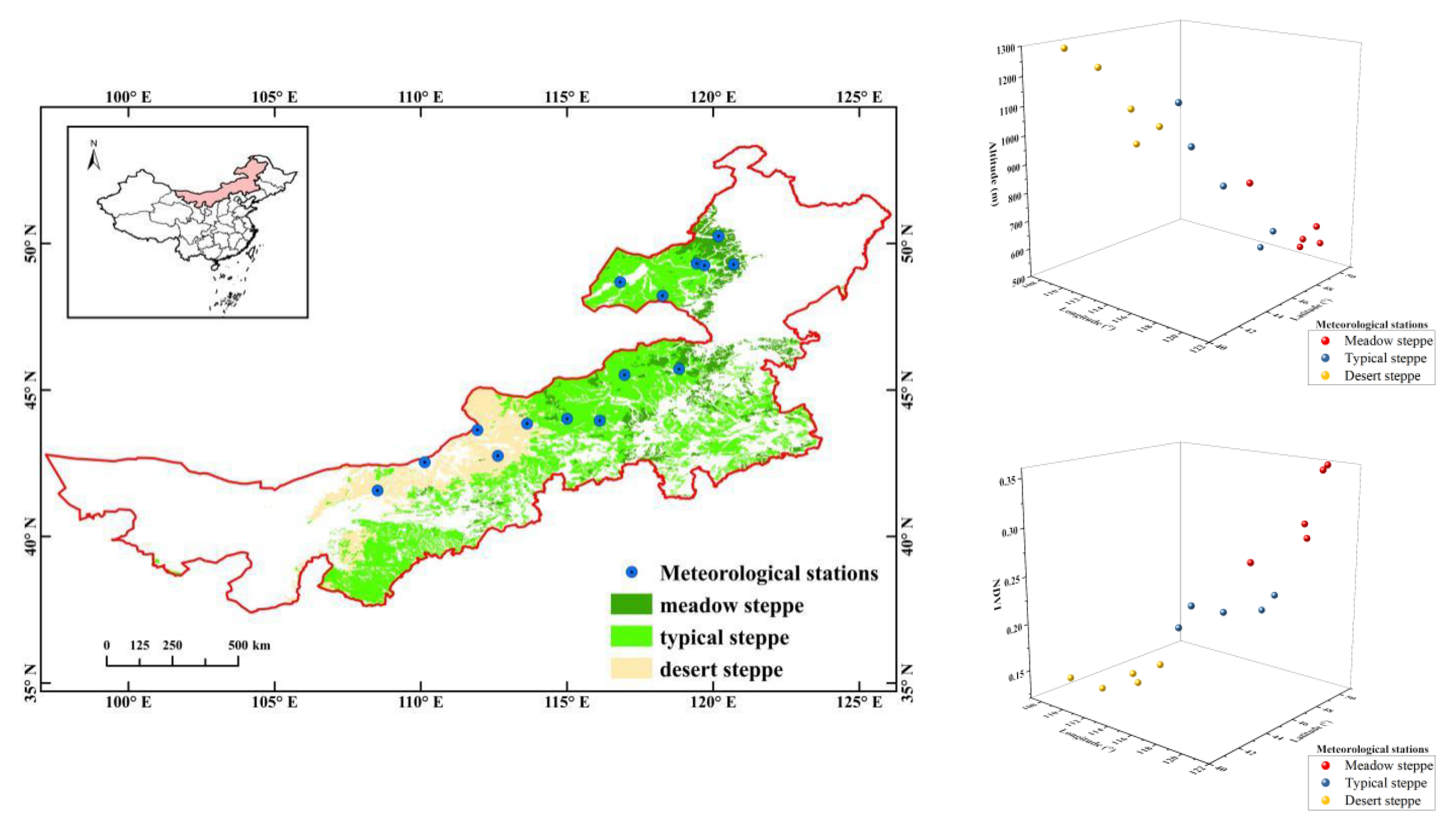
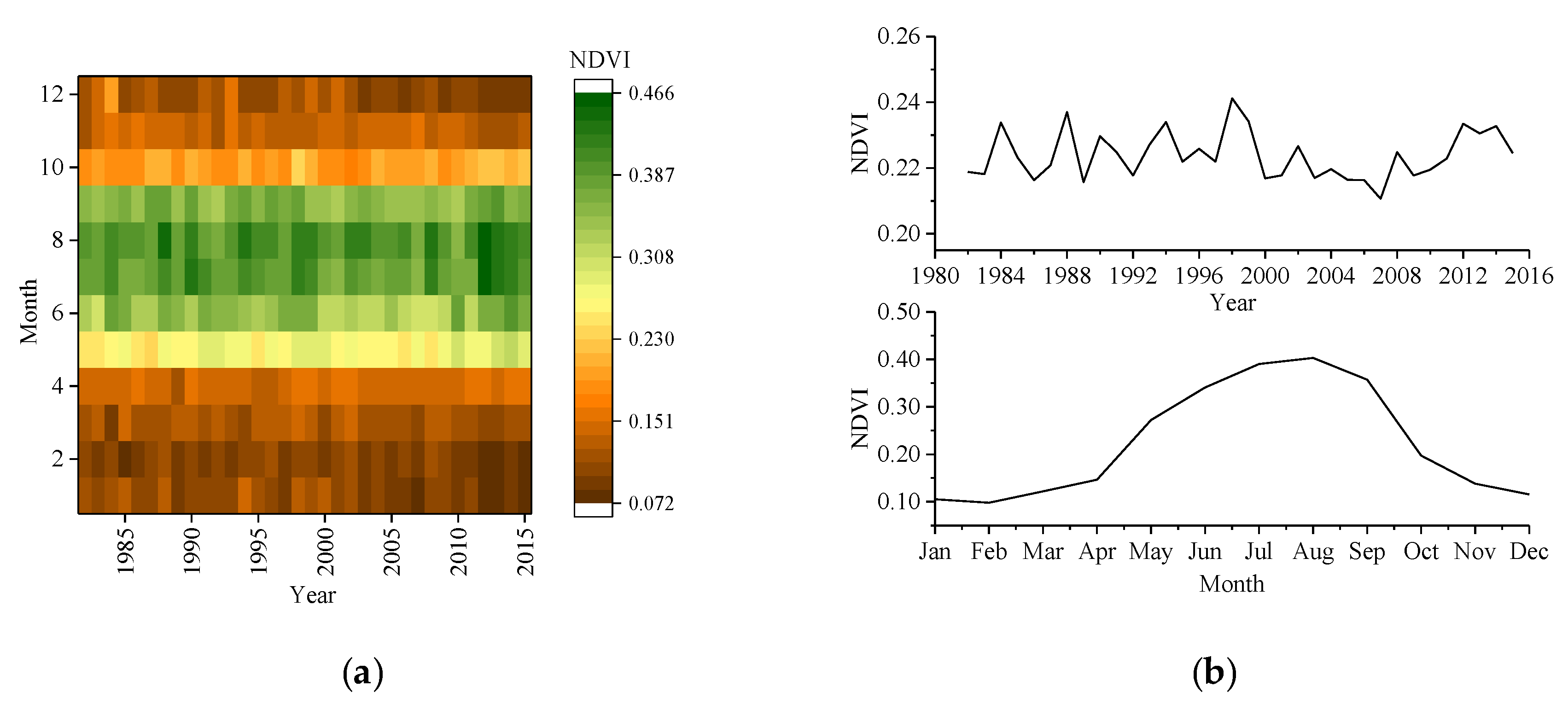
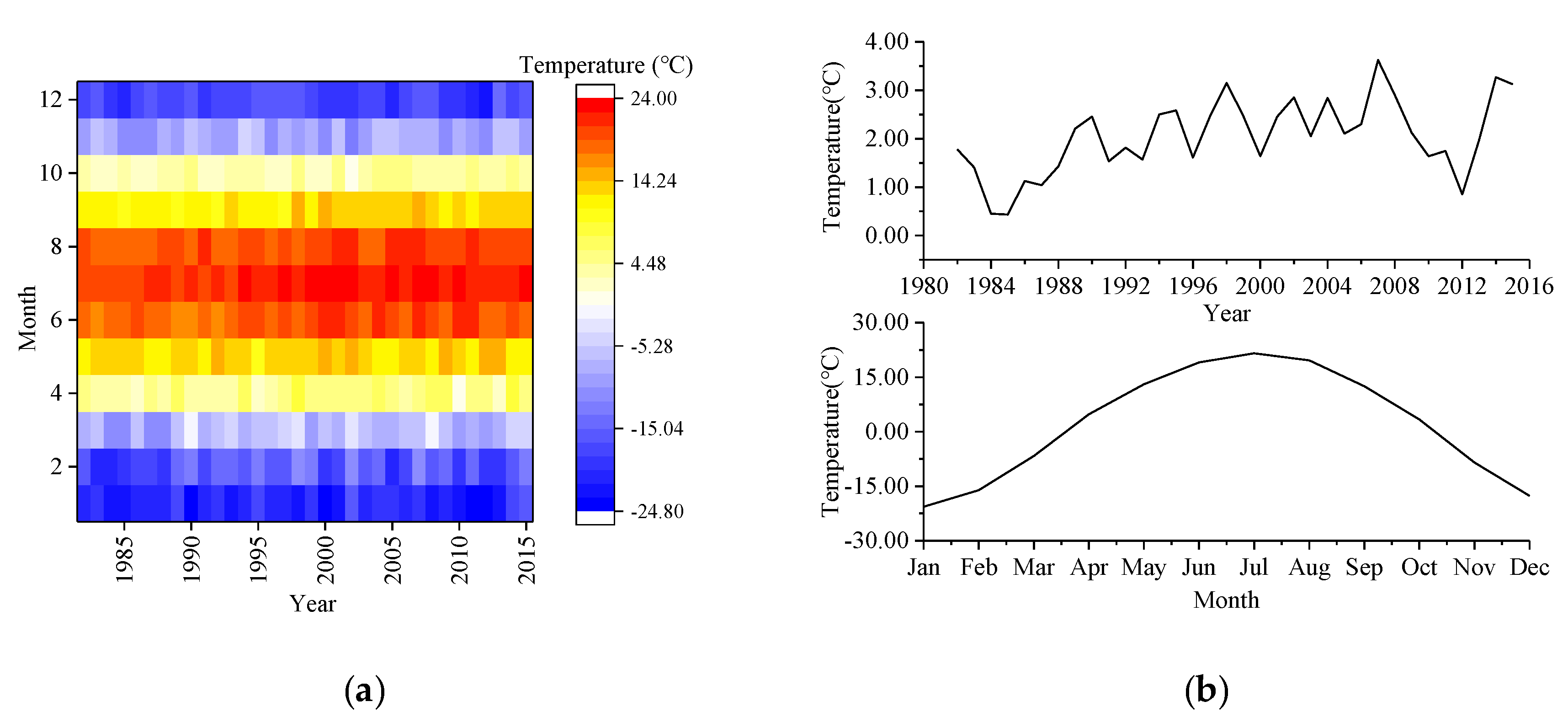


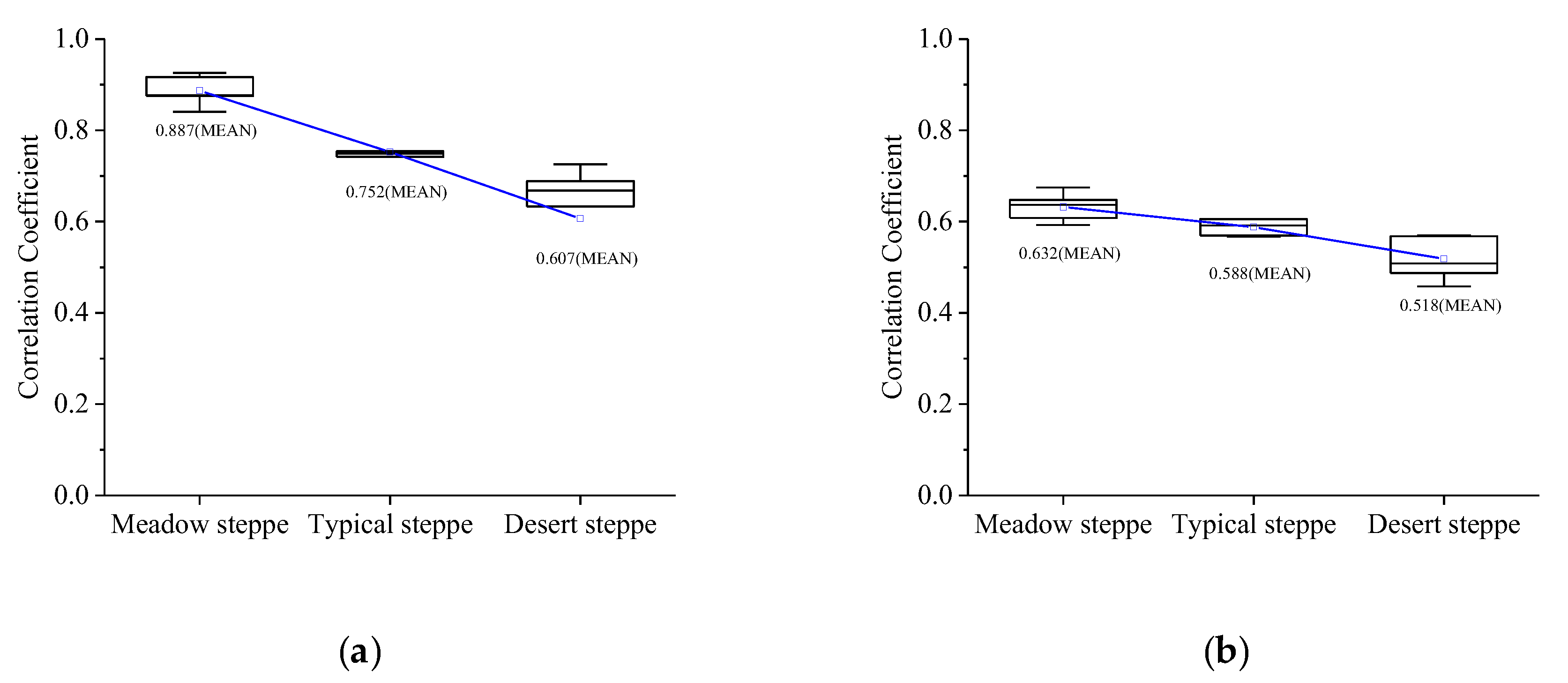

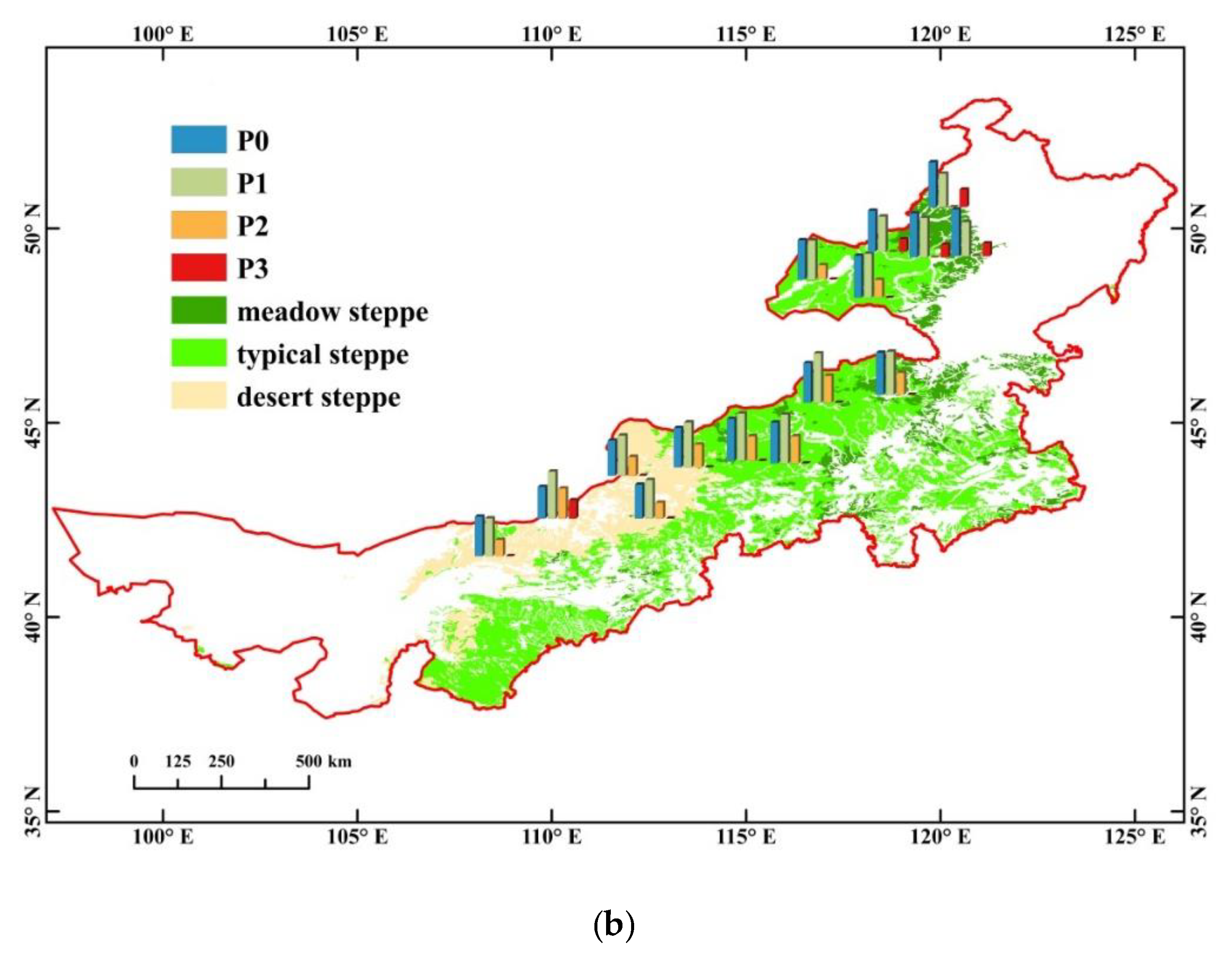
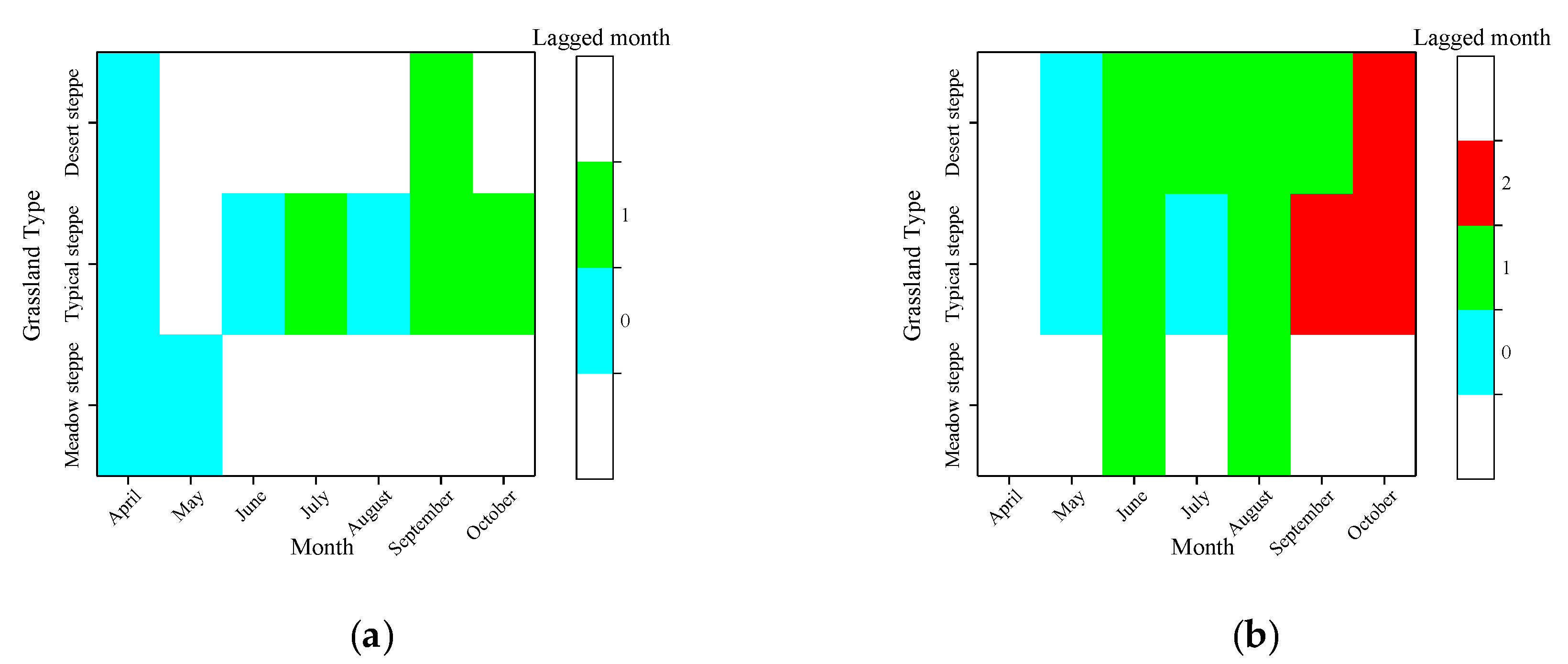





| Grassland Type | Climate Factor | April | May | June | July | August | September | October |
|---|---|---|---|---|---|---|---|---|
| Meadow steppe | Temperature | 0.457 | 0.573 | 0.410 | ||||
| Precipitation | 0.431 | |||||||
| Typical steppe | Temperature | 0.408 | −0.420 | −0.440 | 0.389 | |||
| Precipitation | 0.414 | 0.491 | 0.550 | |||||
| Desert steppe | Temperature | −0.368 | ||||||
| Precipitation | 0.515 | 0.436 | 0.532 | 0.542 |
© 2019 by the authors. Licensee MDPI, Basel, Switzerland. This article is an open access article distributed under the terms and conditions of the Creative Commons Attribution (CC BY) license (http://creativecommons.org/licenses/by/4.0/).
Share and Cite
Pei, Z.; Fang, S.; Yang, W.; Wang, L.; Wu, M.; Zhang, Q.; Han, W.; Khoi, D.N. The Relationship between NDVI and Climate Factors at Different Monthly Time Scales: A Case Study of Grasslands in Inner Mongolia, China (1982–2015). Sustainability 2019, 11, 7243. https://doi.org/10.3390/su11247243
Pei Z, Fang S, Yang W, Wang L, Wu M, Zhang Q, Han W, Khoi DN. The Relationship between NDVI and Climate Factors at Different Monthly Time Scales: A Case Study of Grasslands in Inner Mongolia, China (1982–2015). Sustainability. 2019; 11(24):7243. https://doi.org/10.3390/su11247243
Chicago/Turabian StylePei, Zhifang, Shibo Fang, Wunian Yang, Lei Wang, Mingyan Wu, Qifei Zhang, Wei Han, and Dao Nguyen Khoi. 2019. "The Relationship between NDVI and Climate Factors at Different Monthly Time Scales: A Case Study of Grasslands in Inner Mongolia, China (1982–2015)" Sustainability 11, no. 24: 7243. https://doi.org/10.3390/su11247243
APA StylePei, Z., Fang, S., Yang, W., Wang, L., Wu, M., Zhang, Q., Han, W., & Khoi, D. N. (2019). The Relationship between NDVI and Climate Factors at Different Monthly Time Scales: A Case Study of Grasslands in Inner Mongolia, China (1982–2015). Sustainability, 11(24), 7243. https://doi.org/10.3390/su11247243







